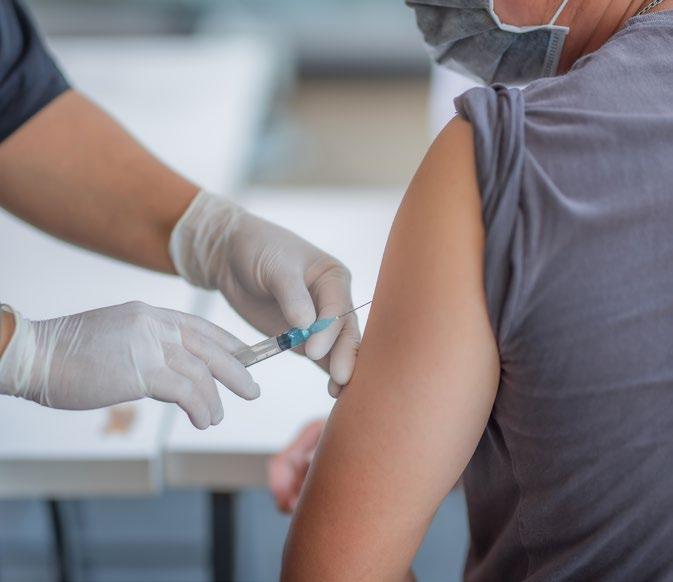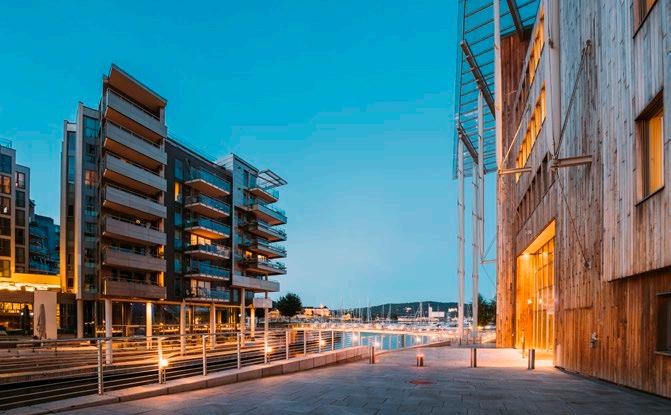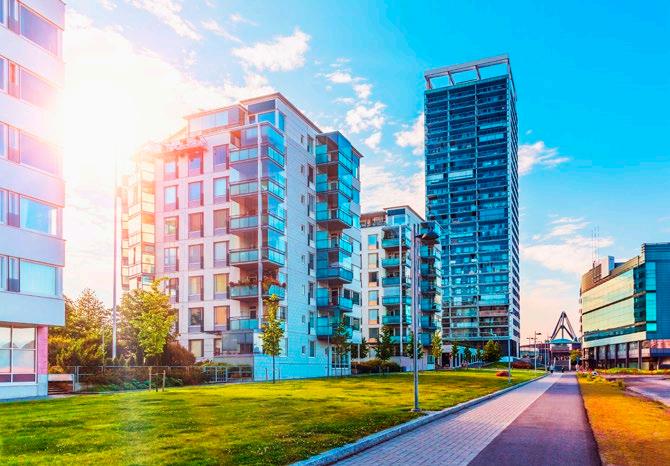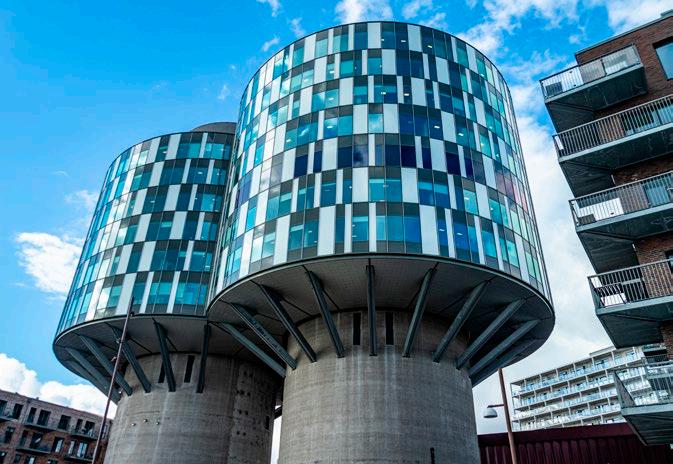
12 minute read
Property After Corona
Photo: iStock
Klas Eklund, Senior Economist, Mannheimer Swartling
Gradually, we seem to be moving out of the most acute phase of the crisis, after the most brutal downturn in modern history. But it will take time before we can declare victory. Unemployment remains high, productivity is hurt by trade wars – and of course, the virus may come back in new waves. Amazingly, property markets have held up well during the pandemic – spurred by record-low interest rates. Economically, the Nordics have fared better than most European countries, but the Swedish death toll during spring was frightening.
A gradual recovery In February, when I penned the macro piece for the spring edition of the Newsec Property Outlook, I stated: “Chinese growth H1 2020 will take a hit… Several nejghbor countries will also suffer, but direct effects on Europe and the US will be small”.
How wrong I was! Economically, the second quarter of 2020 turned out to be the worst ever in peace time in the Western world. While China was the first to start climbing out of the abyss, GDP in the US and most European countries fell by more than 10 per cent. In some countries in Southern Europe about one third of all economic activity was closed down for more than a month. If we add Q1 and Q2 and look at all of the first half of the year, the decline in Spain was 24 per cent and in the UK 23 per cent. The Nordic countries did better, with e.g. Finland down only 5 per cent.
A number of observations indicate that Q3 will showcase an improvement just about everywhere. China is already up and running, and global supply chains were not interrupted as severely and for as long as we feared in the spring. The USA is also rebounding, and the number of temporary layoffs has started to fall. In Europe, too, most countries show improving economic numbers.
Sentiment indicators are up – albeit a bit wobbly. In July, as the rebound picked up speed, there was a general feeling that the recovery could be
stronger than expected. However, the August numbers were not as convincing. Growth was positive, but slower than in July. In several countries there was a marked slowdown in indicators of mobility, travels, hotel nights etc. – again. One reason was signs of the virus spreading again. This creates new uncertainties and makes forecasting difficult.
Uncertainty is great • First of all, we don’t know when there will a tested vaccine available and distributed. That can take time.
During that period we run the risk of new virus waves.
Secondly, the number of new virus cases in emerging markets is still rising. This will continue to dampen global demand and international exchange of both goods and services. The number of people in poverty will rise.
Thirdly, part of the economic rebound has been fueled by extraordinary fiscal stimulus, which is not sustainable in the long run. How and when that stimulus is pulled back can have crucial effects.
Fourth, economic pain in several sectors will be with us for a while. Tourism, air travel, and some other parts of the service sector will suffer a long time before customers deem it safe to pick up demand again.
Fifth, the labor market is a lagging variable. Often, it takes time for those who lose their jobs to find new ones. The risk is obvious that unemployment will remain high for quite a while. The labor market is crucial. Here, unemployment numbers rose to over 10 per cent in the US during summer, and 7 per cent in the EU. The reason unemployment did not rise even more was big support schemes and shortterm work programs. Hopes were that by now unemployment would decline. But the hoped-for improvement is already showing signs of petering out. This puts governments in a bind. They need to move from wage subsidies to more traditional jobless benefits – while also providing incentives to look for work. The short-term work schedules are not designed for this.
“The dance” Despite all this fog of uncertainty, it seems reasonable to assume a gradual recovery in the economies in the advanced economies. But it will probably be uneven, with setbacks as new, major or minor virus outbreaks occur. This is happening both in the US and in several European countries. However, even if there are new regional clusters of virus outbreaks, my guess is that authorities will not revert to full-scale lockdowns on a national scale. Like it or not, I simply don’t believe citizens will accept another round of confinement after the experiences of last spring.
Thus, we will probably see what has been called a period of “dance” with less stringent measures intermittent with stricter ones, varying locally and over time, as the virus comes and goes. A full restart of the economies is probably not viable until there is access to an effective vaccine.
Economic growth will thus see spurts and fits and setbacks for the foreseeable future. Sentiment will shift up and down, and economic activity with it as people will change their behaviour, e.g regarding travel and dining out. Possibly, countries with a greater degree of trust will show stronger resilience.
The conclusion is that GDP numbers will turn out negative for the whole of 2020, and the uptick next year will not be enough to bring us back to where we were before the pandemic struck.
Low inflation, low rates Despite a massive monetary stimulus, inflation will stay low, in all European countries, due to low demand, low capacity utilization, high unemployment and low energy prices. During summer, the ECB set in place a policy framework – Pandemic Emergency Purchase Programme PEPP - which will provide ample support throughout this year and well into 2021. Consequently, the bank’s policy rates will remain extremely low for the foreseeable future, as will market rates, thus supporting asset prices.
Nonetheless, central banks are starting to scratch their heads, pondering what to do in the longer term. Nobody knows whether the growing pile of debt will bring financial repression (i.e financial regulation to hold down market rates) or maybe a bout of inflation. It seems as though some central bankers in the latter case would be willing to let inflation rise above the present target, to stimulate growth and repay some of the government debt. The Federal Reserve is debating this. Such a development, however, would be somewhere in a hazy future – since it means key rates will be raised later rather than sooner – and does not bother financial markets right now.
Market rates are extremely low – nominal 10 year government bonds trade around zero in many countries. Stock markets have consequently rebounded. The hunt for yield in this market environment has tightened the spread to mortgage bonds as well. As a result, property markets have fared surprisingly well, also during the pandemic. In the US, e.g. the housing market (housing starts as well as existing home sales) has shown a clear V-shaped pattern with a strong rebound during summer.
Winners and losers The virus has forced us to change behavior. Working from home, hardly any travelling or dining out, less physical shopping – but a quantum leap for e-shopping and zoom meetings. The tech sector has gained – both in sales and when it comes to stock market

capitalization. Traditional brick-andmortar services have suffered; hotels, restaurants, event managers, travel companies. Market caps have swung wildly, despite being given support by low interest rates.
Housing has done well, courtesy of low interest rates. House prices fell in the early spring in most countries, but during summer prices recovered in most countries. In the Nordic countries, as we shall see, real estate has been more stable than in many other countries.
Long-term trends may shape the housing and property markets in hitherto unexpected ways. Digitalisation and social distancing have changed the way we use our homes. Many of us have streamed meetings from home, which necessitates bandwidth and
Photo: iStock
sometimes encryption. Travelling to work does not occur every day. To a large extent these trends will stay with us also after the pandemic.
Those who can afford to may want to upgrade their homes, maybe adding an extra room that can be used as an office. Maybe the demand for houses further away from work will increase, at the expense of smaller apartments in the city. This means demand patterns may change.
The Nordics The Nordic region has followed the general trend, but with a slightly better economic performance than most of Europe, in particular for Finland. Sweden stands out, with health measures (lockdown, quarantines, social distancing) less stringent than its neighbors, and indeed less stringent
than almost all other advanced economies. This is probably one reason why the death toll has been far higher in Sweden than in the other Nordic countries.
GDP change (%), 2020 H1 (preliminary numbers)
Sweden
Norway Denmark
Finland
Euro zone -8.3
-8.3
-9.3
– 5.0
-15.3
A debate has raged regarding whether the Swedish economy may have gained slightly from this lenient

Photo: i Stock
approach. The evidence is not clearcut. Sweden has indeed performed better than Southern Europe. But Finland has recorded a better growth performance so far, and Norway and Denmark about the same, despite more stringent lockdowns. Although the jury is still out – we have to wait with a verdict until the pandemic is defeated – it is clear that the Swedish virus-related deaths during the spring were much higher than the country’s neighbors.
Sweden The consensus view is that Swedish GDP will shrink by 4–5 per cent in 2020 and gain 3–4 per cent next year. Private consumption experienced a record-breaking fall in Q2 but is now recovering. Manufacturing and tech will do well, the public sector is expanding courtesy of fiscal stimulus, but the service sector is lagging. Unemployment is high and will rise well into next year.
Recession and fiscal stimulus mean that public debt will rise. But the level will still be low, as Sweden is AAA-rated, and the yield on 10-year government bonds is zero.
Inflation remains far below the Riksbank’s target. Even so, the bank has so far not shown any willingness to go back to negative rates. However, since the Riksbank crawled out of negative territory, the SEK has strengthened considerably, pushing down inflation even more. There may, consequently, be some pressure on the Riksbank to
»Property has been resilient in all the Nordics throughout this turbulent period, and should perform well also for the foreseeable future«
cut the repo rate below zero again. But the main forecast is still that the repo rate will remain at zero with an even more active use of quantitative easing and yield curve control.
House prices fell in 2017, recovered, fell again at the beginning of the pandemic and jumped back during summer. Households have turned more optimistic about future prices. Construction has remained solid throughout the economic crisis. All in all, the housing and construction markets have shown resilience.
Denmark The Danish experience is different than that of Sweden, since Denmark enforced a strict lockdown early on. This has held down virus contagion and corona-related deaths far below the Swedish level. Still, the GDP contraction has been even worse than in Sweden. The GDP fall in H1 eradicated four years of growth in just six months…
Private consumption is rebounding, as the economy is opening up at a swifter pace than in most countries. The government has decided upon new stimulus packages also for 2021–22. The consensus GDP forecast is minus 4–5 per cent in 2020, which is clearly stronger than the European average. For 2021 the forecasts hover around plus 3 per cent growth. Unemployment has risen to 7 per cent, which is close to the European average.
Inflation is low, as everywhere else, and Denmark’s central bank shadows the ECB in order to hold the krone in a very narrow trading band to the euro. No change in monetary policy is visible on the horizon. Finland The Finnish economy has shown remarkable resilience, with growth numbers clearly stronger than most European countries. Finland was quick in closing down during spring, and working from home was more common in Finland than in any other European country. The per capita number of dead from covid-19 is the lowest in Europe, and this has helped hold up consumer confidence, which is now even higher than before the pandemic. Consequently, consumption has shown resilience.
Manufacturing was less affected in Q2 than in any other European country. But looking ahead, the structure of Finnish exports (investment goods) may be hampered by slow foreign demand. Unemployment has risen to 8 per cent. The GDP forecast for 2020 is minus 3 per cent. The forecast for 2021 is growth of around 2 per cent, which is the lowest in the Nordic region. So Finland may experience the shallowest recession among the Nordics; the downturn was less abrupt, but the upturn will also be less vigorous.
Inflation this year is close to zero. Since Finland is a member of the Euro Zone, the key rate is set by the ECB – meaning it is negative, giving strong support to the property market.
Norway The Norwegian development saw more stringent measures than in Sweden during spring and summer, but the economic performance has been similar to Sweden. One reason is that Norway’s oil and gas sector was also hit by low energy prices. Now, a recovery is under way and consumer spending is gathering momentum. Oil prices have risen somewhat and tax reforms support investments in the offshore sector. GDP is expected to fall by 4 per cent in 2020.
Norway is different in the sense that it is not an EU member. Strong growth and slightly higher inflation for a long time made Norges Bank keep key rates clearly above neighboring countries, strengthening the krone. The pandemic, however, made the central bank cut its key rate in two bold steps to zero, whereupon NOK was corrected from overvalued levels.
Falling rates and a loosening of credit has led to a rise in housing prices. Indeed, there are already signs that over-heating may return. Norges Bank is worried about financial imbalances, and will probably be the first central bank to hike – but not for at least another year.
All in all While I underestimated the corona effects in the spring edition of Newsec Property Outlook, I was a little more lucky in predicting strong property markets. Indeed, property has been resilient in all the Nordics throughout this turbulent period. The reason is, of course, record-breaking stimulus, from both monetary and fiscal policy. As rates will continue to stay low and fiscal policy will not be tightened for some time – out of fear of halting the recovery – property markets should perform well also for the foreseeable future.









